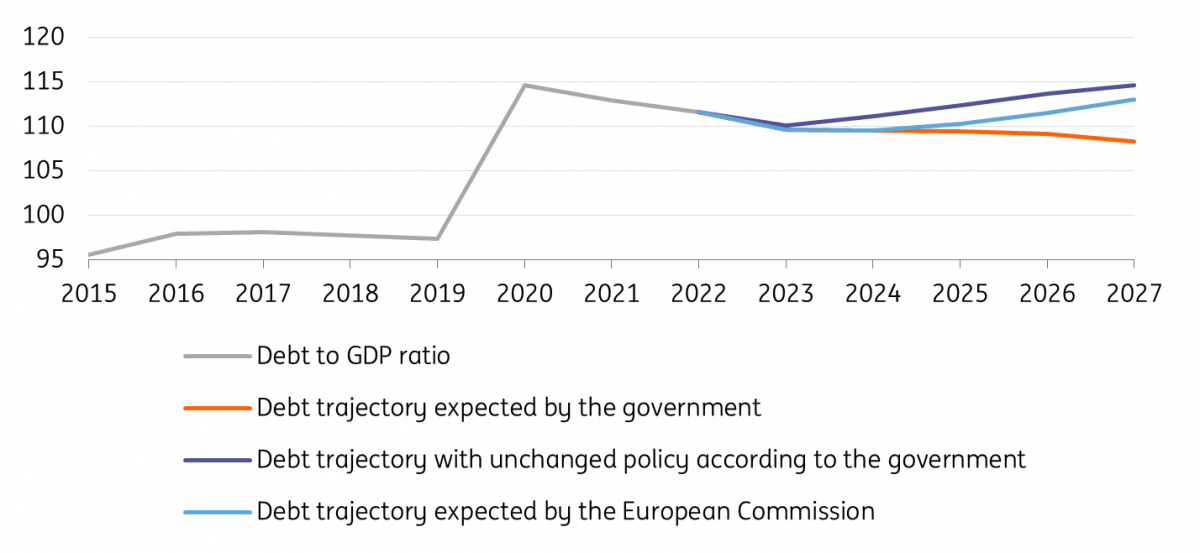The sustainability of France’s public debt moves back into the spotlight
In France, the sustainability of public finances has once again become an important issue for the government, the general public and the rating agencies alike in a context of economic slowdown, rising interest rates and a minority government in parliament. The market reaction has been muted so far but the trend is towards wider spreads
The context has changed
Since 2020 and the famous "whatever it costs" imperative of President Emmanuel Macron, public finances have largely supported the French economy, helping it to get through the pandemic, with a strong recovery after the lockdowns, and clearly limiting the inflationary shock linked to the energy crisis. Against this backdrop, the question of the sustainability of France's public finances had disappeared from the public debate, and the sharp rise in debt or the much higher-than-expected deficit got little attention, as the media strongly focused on the much-contested pension reform.
In recent weeks, however, the tide has turned radically, and the sustainability of public finances has once again become an important issue, for the government, for public opinion and for rating agencies alike. What explains this sudden change? And what is the state of France's public finances? Let's take a look.
Uncertain debt reduction
Already well above the eurozone average, the 'whatever it costs' approach of the government has led to a significant increase in French public debt since the pandemic, rising from 97.4% of GDP in 2019 to 111.6% of GDP in 2022. Over the period, this represents an increase of 14.2 percentage points, the highest among eurozone countries after Spain. By the end of 2022, France was the fifth country with the highest debt-to-GDP ratio in the eurozone, well above the European target of 60%. If policy remains unchanged, the government estimates that public debt could continue to rise over the next few years, reaching 114.6% of GDP in 2027.
The path towards debt reduction is difficult

At the same time, it is becoming harder for the government to implement major reforms. Indeed, President Macron lost his majority in parliament in the June 2022 legislative elections, making it very difficult to enact reforms. In addition, the recent protests surrounding the pension reform, whose stated aim was to raise the retirement age in order to limit the rise in the cost of the system, have been fierce and have shown the public's very low appetite for reforms that lead to a reduction in public spending. Against this backdrop, although the government has stated its intention to bring public debt under control and to bring it down to 108.3% of GDP by 2027, there are some doubts about the feasibility of this trajectory.
Also, the cost of financing the debt has risen significantly. Firstly, because of the sharp rise in interest rates, which has led 10-year rates on debt to rise by almost 300 basis points since the end of 2019. This rise in rates is gradually being passed on to all debt, at a rate of around 15% per year of the outstanding amount issued or reissued. According to estimates by the Banque de France, each 1% rise in interest rates will, after 10 years, lead to an increase in the annual interest burden of 1pt of GDP (or €40 billion), and an increase in debt of 5.5pt of GDP, compared with a situation without a rate rise. In addition, one tenth of the debt is indexed to inflation, so that each additional point of inflation leads to an immediate rise in the implicit rate on the debt of around 0.1 percentage points (though this might be partially mitigated by a higher nominal GDP). In short, having reached the low point of 1.2% of GDP, the interest burden on the debt is set to rise inexorably over the next few years. The government expects it to reach 1.9% of GDP in 2024 and 2.4% of GDP in 2027.
The sustainability of public finances also depends to a large extent on economic activity. It has become clear that the outlook for growth is deteriorating and there are increasing signs of a future economic slowdown. The French government is basing its debt and public finance projections on a GDP growth assumption of 1% in 2023 and 1.6% in 2024. However, given the latest available indicators, these assumptions seem over-optimistic. The European Commission is forecasting 0.7% and 1.4% growth for 2023 and 2024, while we are expecting only 0.5% and 0.6%. Weaker growth means that the debt trajectory will be less positive than expected.
Rating agencies in downgrade mode
Finally, with this in mind, the rating agencies are taking a close look at the trajectory of France's public debt. Fitch lowered France's debt rating from AA to AA- at the end of April, while Scope lowered its outlook last week. All eyes are now on S&P, which is due to publish its conclusions this Friday and indicate whether it will go lower than the current AA rating with a negative outlook. The government, led by Economy Minister Bruno Le Maire, is trying to sell the deleveraging strategy, meeting S&P officials several times to try to convince them of the will to change course and get out of the 'whatever it costs' for good.
Muted market reaction but the trend is towards wider spreads
Bond markets have had a long time to get used to the idea of deteriorating French debt metrics, and it is fair to say that the spread widening against better-rated sovereigns has been gradual.
As always, a bit of history is useful. When sovereign spreads exploded upwards a decade ago during the European sovereign debt crisis, foreign buying was in part credited with preventing France from joining the club of high-debt, wide-deficit countries that risked losing market access. With Japanese buying of foreign bonds having turned to net selling last year, that support has disappeared. Subsequently, the European Central Bank's intervention in the government bond market through quantitative easing successfully suppressed sovereign credit risk. Here too, the net buying has turned to net (passive) selling.
This is not to say that we’re expecting a repeat of the euro sovereign crisis, but two key tailwinds have disappeared for French bonds. This should make sovereign debt, including that of France, that much more sensitive to a deterioration of their issuers’ credit quality. There are some saving graces that we should mention. Large positive interest rates mean a large number of potential buyers sidelined by negative yields have returned to government bond markets. What’s more, the reduction in central bank reserve availability means government bonds should gain in popularity with banks. The upshot is more volatile, and likely wider spreads going forward, although the process should be gradual.
The trend is towards wider spreads
Ultimately, the return of the issue of the sustainability of public finances to the centre of French concerns is a sign that circumstances have changed radically in recent months and have become much less favourable. We can expect the subject to become much more important again in the next few years, both in France and in the rest of Europe. In that regard, all eyes are now also on the reform of the Stability and Growth Pact which should be decided this year.
This publication has been prepared by ING solely for information purposes irrespective of a particular user's means, financial situation or investment objectives. The information does not constitute investment recommendation, and nor is it investment, legal or tax advice or an offer or solicitation to purchase or sell any financial instrument. Read more
Download
Download article
